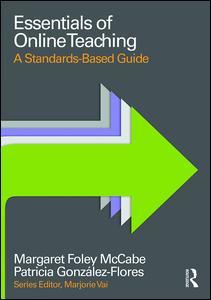Essentials of Online Teaching A Standards-Based Guide Essentials of Online Learning Series
Auteurs : Foley McCabe Margaret, González-Flores Patricia

Teachers? active online participation and engagement with students are critical factors to the success of online courses. Essentials of Online Teaching is a standards-based, straightforward guide to teaching online in higher education, high school and vocational training, or corporate learning environments. This brief but powerful book encourages immediate application of concepts with the help of real-world examples, technical insights, and professional advice.
The guide includes:
- a practical approach informed by, but not about, relevant learning theories;
- clear models and examples from a wide variety of online courses;
- teachers? reflections about their online practice;
- a checklist of standards to help guide teaching decisions; and
- an accompanying website (www.essentialsofonlineteaching.com) with additional resources.
Essentials of Online Teaching addresses key instructional challenges in online teaching and presents the reader with practical solutions for each phase of a course?preparation, beginning, middle, and end.
Foreword, About the Authors, Introduction to this Guide
i.1 The Distinction Between Course Design and Teaching
i.2 A Unique Guide for Online Teaching
1.3 Who Will Benefit from this Guide?
i.4 A Standards-Based Approach
i.5 Organization of the Book
i.6 Chapter Features
i.7 Terminology
1. Orientation to Online Teaching
1.1 Evolution of Online Education
1.2 A Spectrum of Online Course Models
1.3 The Online Environment
1.4 Attributes of Online Teaching and Learning
1.5 Online Teaching Responsibilities
1.6 Example: Overview of a Week Online
1.7 Time Expectation for Teachers
1.8 Summary and Standards
2. Factors that Influence Online Teaching
2.1 Online Teaching
2.2 Online Learners
2.3 Course Content and Learning Objectives
2.4 The Online Environment and the Tools Used
2.5 The Mission and Priorities of the Host Institution
2.6 Influences in Action: Sample Course
2.7 Summary and Standards
3. Teaching with Digital Tools and Resources
3.1 Supporting Learning with Digital Resources and Tools
3.2 Communicating with Students
3.3 Sharing Resources with Students
3.4 Assessing and Grading Student Learning
3.5 Creating Collaborative Resources
3.6 Beyond the LMS
3.7 Summary and Standards
4. Preparing to Teach Online
4.1 Planning Your Teaching
4.2 Defining the Course’s Timeframe
4.3 Setting the Stage for Interaction
4.4 Preparing Course Materials
4.5 Establish Procedures for Technical failures
4.6 Summary and Standards
References and Further Reading
5. The Beginning Weeks: Launching an Online Course
5.1 Helping Students to Work in the Environment
5.2 Encouraging Communication
5.3 Building Self-Directed Learning Skills
5.4 Reflective Teaching: Learning as You Go
5.5 Summary and Standards
6. The Middle Weeks: Facilitating Online Learning
6.1 Guiding Students Through the Plan
6.2 Humanizing the Online Environment
6.3 Gathering Information About Your Students’ Progress
6.4 Improving Your Course
6.5 Example of the Course Improvement Strategy in Action
6.6 Summary and Standards
7. The Ending Weeks: Synthesizing and Extending Learning
7.1 Helping Students to Reach the Finish Line
7.2 Promoting Self-directed Learning
7.3 Reviewing and Synthesizing Learning
7.4 Concluding the Course
7.5 Summary and Standards
8. Online Collaboration
8.1 Weighing the Benefits and Drawback of Collaboration
8.2 What Makes a Good Collaborative Discussion?
8.3 What Makes Successful Group Work?
8.4 Summary and Standards
9. Online Assessment
9.1 Communicate a Clear Assessment Plan
9.2 Gather a Variety of Information about Students’ Learning
9.4 Provide Ongoing Feedback
9.5 Share Responsibility for Providing Feedback
9.6 Guard Against Cheating and Plagiarism
9.7 Summary and Standards
10. Pulling It All Together: An Online Teacher in Action
10.1 The Teacher and the Course
10.2 Factors that Influence Online Teaching
10.3 Digital Tools and Resources
10.4 Preparing to Teach Online
10.5 The Beginning Weeks
10.6 The Middle Weeks
10.7 The Final Weeks
10.8 The Essentials of Online Teaching
10.9 Summary and Standards
Appendix A: Using the Standards Checklist, Index
Margaret Foley McCabe works with universities and other institutions to provide quality online programs through her consulting company, GoodTeachingOnline.com. She launched her first online faculty development program for The New School in 1994.
Patricia González-Flores promotes teaching innovation at the Department of Educational Development and Curriculum Innovation of the National Autonomous University of Mexico. For more than 25 years, she has participated in distance education initiatives in both corporate and academic contexts.
Date de parution : 12-2016
17.8x25.4 cm
Date de parution : 12-2016
17.8x25.4 cm
Thème d’Essentials of Online Teaching :
Mots-clés :
Online Teaching; Discussion Forum; Essentials of Online Teaching; Work Habits; Meg Foley; Follow; standards; Upload; higher education; Online Teachers; k-12; Online Course; corporate learning; Face To Face; online resource; Canvas LMS; Millersville University; assessment; Teaching Tip; curriculum; Student Performance Data; LMS Tool; B Ut; Clips; Live Sessions; Online Learning; LMS; Timeline; Ut La; Middle Weeks; Core Learning Resources; Discussion Prompt; Teacher’s Introduction; Icebreaker Exercise



